Manuscript accepted on : 09 September 2016
Published online on: --
Plagiarism Check: Yes
Efficiency of Gamma Ray to Induce Genetic Diversity in Potato
Ahmad Ziaei1, Ahmad Mousapour Gorji2* and Davoud Hassanpanah3
1Department of Agronomy and Plant Breeding, College of Agricultural, Eslamshahr Branch, Islamic Azad University, Eslamshahr, Iran.
2Vegetable Research Department, Seed and Plant Improvement Institute (SPII), Agricultural Research, Education and Extension Organization (AREEO), Karaj, Iran.
3Horticulture Crops Research Department, Ardabil Agricultural and Natural Resources Research Centre, AREEO, Ardabil, Iran.
DOI : http://dx.doi.org/10.13005/bbra/2371
ABSTRACT: To study on irradiation yield, two cultivars, Kennebec and Banba, were irradiated with different gamma doses. One hundred and eight suitable genotypes were selected and they were cultivated in four replications as yield primary test (augmented). Twenty seven different genotypes -in any iteration- along with five commercial varieties (Agria, Kennebec, Banba, Marfona, and Caesar) were cultivated. The meancomparison results fortuber’s dry mattershowed that clones B20-20, B20-11, and B20-101 in Banba populationhave 10% advantage more than their primary parents, and about Kennebec population this advantage reaches to more than 5% for clones K25-7, K20-21, and K20-27. The maximum of increasing and decreasing in the tuber’s flesh color forBanba population was 25% and 43.5% for clones B20-11 and B20-114 respectively. About Kennebec population this color change was remarkable in clones K20-16, K20-45, and K20-30 (49.2%, 35.2%, and 18.3% respectively). The range of yield change was between 0.04% to 56.7%, in positive side, and 0.05% to 66.2% in negative side. In comparison to their parents,the clones B20-24, B20-122, B20-44, and B20-76 in Banba population, and the clones K20-67, K20-70, K20-71, K20-28, K20-26, K20-30, and K20-47 in Kennebec population had better yield. The results from cluster analysis and coefficient of variations revealed that degree of diversity wasn’t considerable among studied population. The different gamma doses had different effects on the varieties of potato,and traits including specific gravity, height, and tuber’s dry mattershowed least changes but yield and its components presented the greatest variations. It seems that generally irradiation has more negative effect on potato’s traits and it is less successful in improvement of traits regarding the potatovariety.
KEYWORDS: Potato; Qualitative and Quantitative Traits; Irradiation; Diversity
Download this article as:| Copy the following to cite this article: Ziaei A, Gorji A. M, Hassanpanah D. Efficiency of Gamma Ray to Induce Genetic Diversity in Potato. Biosci Biotech Res Asia 2016;13(4). |
| Copy the following to cite this URL: Ziaei A, Gorji A. M, Hassanpanah D. Efficiency of Gamma Ray to Induce Genetic Diversity in Potato. Biosci Biotech Res Asia 2016;13(4). Available from: https://www.biotech-asia.org/?p=17282 |
Introduction
Ionizing ray is one of important tools for mutation improvement that leads to higher genetic diversity in plant germplasm[1]. In comparison with spontaneous mutations, induced ones are more useful because such mutations occur in a relative higher frequency and we can use them practically [2]. Mutagenesis by irradiation is used for improvement of some plants including main corps[3,4], ornamentals (Mandalet al., 2000 and Misraet al. 2003), and fruit trees [5,6]. The combination of different tissue culture methods (e.g. micro-propagation) with irradiation is recommended by International Atomic Energy Agency in order to make genetic changes and to increase quality ofvegetative plants [7,8]. The genomic mutations, structural changes in chromosomes, genic mutations and extranuclear mutations are four kinds of mutations that may occur during mutation inducing in potato [9]. The findings showed that irradiation on the potato’s tissues and parts is usually used and the plant parts that mostly were exposed are tubers[10, 11, 12,13], in vitro plantlets[14,11,15], and even true potato seeds [16]. At the present time the reports of mutation improvement by irradiation focused on traits such as induced resistance against biotic and abioticstresses[11,17,18], starch quality [19], increased performance[14,15], the characteristics of tissues and cells [13] and the length of growth period [20]. According to all studies, irradiation may play an important role in improvement of some useful and commercial traits of potato. Investigations shown that gamma irradiation affected onincreasing of starch value[8,15], amount of reducing sugar, carbohydrates and resistance to diseases [21], the color of skin and flesh[22], resistance to Phytophthora[23,24,8], increasing of salinity tolerance [25,26], andincreasing of heat tolerance [23]. Ahloowalia[27]investigated about possibility of genetic mutation inducing by irradiation in four varieties of potato –Record, Pink, Kerrd, and Redcard Care- and observed some changes including changes in the color of skin and eye, eye-depth, tissue’s quality, and tuber’s shape. Sonnhno [28] found that by irradiation on single-sprout shoot of Desiree variety some changes occur in tuber size, leaf shape, leaf color, stem color and shape, skin color of tuber, flesh color and tuber texture. After investigation on the effect of various gamma doses (30, 50, 70, 120Gy) on the amount of starch and Amylose in sweet potato Shine [15] reported thatmaximum amount of starch and Amylose is produced under 50 Gy. In order to give the plantlets of Diamant variety diversity of resistanceagainst salinity Sharabash[26]investigated on the effect of various gamma doses (0, 20, 40 Gy) with 2000 and 4000 ppm sodium chloride, and he concluded that 20 Gy is the best dose to this aim.In addition, he reported that in vitro irradiation method leads to higher genetic diversity about tolerance to salinity in potato. vanEnckevortet al.[29]after investigation on in vitro irradiated diploid and monoploid potatoes under different gamma doses (0 to 16 Gy) reported that favorable dose is between four and eight. In this experiment 582 resistant plants were selected.To find a resistant variety to Phythophthora,Gosalet al.[23]evaluated on in vitroKufriJyoti and KufriChundramokhi varieties under 20 and 40 Gygamma doses and identified that 36% of KufriJyotiplantsand 42% of KufriChundramokhi plants showedresistance to Phythophthora. These samples also were examined for tolerance against heat and the results showed that obtained materials have resistance to heat. Das et al.[11]studied on two commercial varieties, Kufrijyoti and KufriChundramokhi, by irradiation of their stems to produce heat-resistant lines. They could to produce heat-resistant lines from the primary parents in this investigation.Cheng et al.[30] performed an investigation to find the effect of gamma ray radiation on physiologic and morphologic feature and chromosomal abnormalities of potato minituber. They exposed the Shepodyminitubers to various gamma ray doses (0, 10, 20, 30, 40, 50, 60, 70, 80 Gy) and found that the sprouting ratio (%) in low-doses irradiated minitubers is increased significantly in comparison with other doses. And the plant growth of high-doses irradiated microtubers decreased.
Materials and Method
The plantlets produced from Kennebec and Banbatissue cultureswere examined for viruses PVS, PVX, PVY, PLRV, PVA by serology method (ELISA) using ELISA reader in 405nm. The intensity of virus contamination for above viruses was determined by measurement of absorbed light by wells. After detecting healthy plantlets, they were propagated. Sproutswere transferred to gammacelland were irradiated by gamma ray in intensities of 20, 25, 30, 35, 40, and 45 Gy to find suitable dose according to 50% growth decrease (length of stem). After suitable dose determination, 1000 sprouts were subjected to irradiationbyeach detected suitable dose. These irradiated sprouts with 20 non-irradiated ones (controls) were transferred to MS environment and microtubers were produced from them after three sub-cultures. The time period between each sub-culture was 40-45 days. Theminitubers were produced from the cultivation ofmicrotubers in greenhouse.The produced genotypes were examined to determine their tuber’s dry matter, and flesh color, then 108 favorable genotypes were selected and with five controls –Agria, Kennebec, Banba, Marfona, and Caesar- as an augmented design were studied in Seed and Plant Improvement Institute. The genotypes were cultivated infour replications;each repetition includes 27 different clones and 5 similar controls: Agria, Marfona, Kennebec, Banba, and Caesar. The genotypes were cultivated in two 3 meters long rows, 75 Cmbetween them and 25 Cm on the row. Some traits including number of main stems, diameter of main stem, height of plant, number and weight of tubers, the weight of single tuber, yield, the percent of tuber’s dry matter, specific gravity, the amount of reducing sugar, and the tuber’s flesh colorwere examined and registered in the period of growth and after physiological maturity of tubers.
Statistical Analysis
To identify the block effect and determination of its effect on studied traits in clones, at first the simple variance analysis of controls were performed according to the complete randomized block design and data were adjusted for block effect. The F test was conductedaccording to the mathematical expectation of mean squares. The variance analysis for all studied genotypes was carried out based on the augmented test about the primary and adjusted data.
The cluster analysis based on the mean of standardized data was computed by the method of Ward and the squared Euclidean distance for all traits in order to group the studied clones.Excel 2010, Minitab 16, and SAS 9.1 were used for variance analysis, determination of diversity level, and cluster analysis.
Results and Discussion
Irradiation
The results from primary examinations showed that although various doses have partial different effects on different potato varieties, but 20 to 25 Gy gamma irradiations lead to better affectin comparison with other doses. The adverse effect from higher doses may be because of chromosomal abnormalities, change in permeability of cell wall, and morphological and physiological damagesinduced by irradiation. Chetanet al.[31] maintained that more irradiation doses decrease cell wall’s permeability and according to their recommendation pretreatment with calcium is a way to relieve the damages from gamma ray irradiation. Cheng et al.[30] stated that the number of cells with chromosomal abnormalities increased with intensity of irradiation, therefore some morphological and physiological problems were observed in the plants grown from these microtubers. The findings of researches by Chetanet al.[31], Shine et al.[15], Sharabash [26], and Gosalet al.[23] also confirmed the results of the present paper and represented that various doses of ray have different effects on potato, and regarding to the irradiated tissue and intended improvement, generally doses between 20 to 40 Gy are more suitable.
Variance Analysis
The results from the simple variance analysis and mean comparison in Table 1 and Table 2 for control samples it is cleared that the block effect on much of traits is significant, therefore data for all traits were adjusted for the block effect with attention to mean deviation of each block from total mean. According to the results of contrast analysis there is a significant difference between genotypes about their traits including tuber’s weight per plant, the number of plant’s tubers, the mean weight of tuber, the plant’s height, the number of main stem per plant, the diameter of main stem, the percent of tuber’s dry matter, reducing sugar level, flesh color, and the yield of tuber. This significant difference illustrates a genetic diversity between genotypes which may be produced because of irradiation (Table 3 and Table 4).The R-squarein fitted model for various traits was between 0.97-0.99; it shows that there is a 97% to 99%justification for changes in studied traits. The results from researches by MousapourGorji and colleagues [32] on mutants produced by gamma irradiation about traits such as the total yield of tuber, the yield of seed and table tuber, the shape of tuber, skin color, the eye depth, thetuber’s dry matter and the presence and the absence of chimera shown that the effect degree ofirradiation on the various traits of potato is different and it leads to different diversity levels in different genotypes of potato. Examining 175 genotypes produced from gamma irradiated Caesarvariety,Hassanpanahet al.[33] reported that there is a significant difference between genotypes about all studied traits.He also concluded that there is a relatively high diversity for traits such as the yield of tuber, the number and weight of tuber per plant, the average weight of tuber, and the number of plant’s main stems.
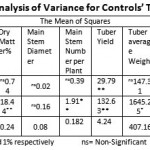 |
Table 1: Simple Analysis of Variance for Controls’ Traits |
Table 2: Mean Comparison for Various Traits of Controls (Block Effect)
| Plant Height(cm) | Flesh Color | Reducing Sugar | Specific Gravity | Dry Matter% | Stem Diameter
(mm) |
Stem Number per Plant | Yield
(t/h) |
Mean Weight of Tuber(g) | Tuber Number per Plant | Weight of Tuber per Plant (g)
|
Block |
| a47.43 | a5.1 | b34.4 | b1.084 | a20.44 | a7.22 | ab5.6 | a38.38 | a101.99 | a7.4 | a724.2 | 1 |
| a48.53 | a5.26 | ab36.4 | b1.084 | ab20.64 | a7.26 | ab5.62 | b35.14 | a35.14 | a7.2 | b663 | 2 |
| a50.31 | a5.4 | a39 | a1.09 | a21.29 | a7.18 | b5.5 | a40.03 | a40.03 | a7.6 | a755.2 | 3 |
| a51.19 | a5.36 | ab38.4 | ab1.086 | ab21.05 | a7.34 | a6.12 | b35.14 | b35.14 | a7.2 | b663 | 4 |
Similar letters Haven’t Significant Difference
Table 3: Contrast Analysis
| Mean square | |||||||
| Main Stem Diameter | Main Stem Number per Plant | Plant Height | Tuber’s Mean Weight | Tuber Number per Plant | Tuber Weight per Plant | Degree of Freedom | Sources of Variation |
| 0.155 | 1.91** | 1846.56** | 1641.70* | 2.08 | 47200.70** | 4 | Between Controls |
| 1.112** | 2.05** | 50.58** | 1914.66** | 32.96** | 69618.39 ** | 107 | Between Genotypes |
| 0.53* | 0.06** | 1170.21 | 7181.66** | 531.53 ** | 308748.28** | 1 | Control x Genotype |
*and** = Significant at 5% and 1% respectively
Table 4:Continue of Contrast Analysis result
| Mean square | ||||||
| Yield of Tuber | Tuber’s Flesh Color | Reducing Sugar | Tuber’s Specific Gravity | Tuber’s Dry Matter | Degree of Freedom | Sources of Variation |
| 132.63** | 20.02** | 173.42** | 0.0004** | 18.44** | 4 | Between Controls |
| 196.57** | 3.26** | 296.31** | 0.0005** | 9.41** | 107 | Between Genotypes |
| 867.35** | 48.58** | 1109.19** | 0.000054** | 1.63* | 1 | Control x Genotype |
*and** = Significant at 5% and 1% respectively
The findings from mean comparison of studied traits based on adjusted data shown that from 108 genotypes 28 genotypes have tuber’s mean weight more than mean weight for controls, and the yield of tuber for 70 genotypes was more than the mean yield of controls.The average weight of tuber was between 22.635 to 231.069 gr, and the average yield of tuber per plant was from 108.65 to 1575.85 gr. Cheng et al.[30] stated that irradiation at lower doses of gamma stimulates tuberizationand leads to higher size of tuber, and subsequentlyincreases the yield of tuber. Sonnhno [28] also has reported the change in tuber size and higher yield of tuber after irradiation.Irradiation at suitable gamma doses caused changes in number of tubers per plant, the number of main stems per plant, the mean diameter of main stem and the height of plant. The range of variations of tuber number per plant, main stem per plant, mean diameter of main stem, and height were 2.25-25.15, 1.59-11.11, 4.47-10.31 mm, and 30.16-87 cm respectively. The range of tuber’s dry matter was between 10.557-26.162% that the maximum and minimum ones belonged to the clones of B20-129 and K25-7 respectively.Trough comparisons between tuber’s dry matters of Banba population and primary parent it is cleared that 27 clones have higher dry matter percent than main parent.This advantage was generally less than 10% except about clones B20-20, B20-11, b20-101, respectively 12.7%, 12.4%, and 11.6%. Only 17 clones in Kennebec population had dry matter more than primary parent and this strong point was maximum 8%. Out of 17 clones only three clones K25-7, K20-21, and K20-27 had dry matter higher than 5% in contrast with main parent.It is worthy to say that the yield of clones with higher dry matter than primary parent was less than main parent. The range of mean specific gravitywas 1.04 to 1.134 and 17 clones had specific gravity higher than mean specific gravity of controls. The ratio of reducing sugar (compared withAgria) for Kennebc variety and 13 clones (6 clones of Banba population and 7 clones of Kennebec population) was less than Agria control, and the rest of clones (95 clones) had higher reducing sugar than Agria. The range of reducing sugar ratio was 0.739-3.552 and its largest and smallest ones were belonged to clones K20-6 and B20-39 respectively (i.e. reducing sugar of clones K20-6 was 3.552 times more than reducing sugar of Agria).And about the color of tuber’s flesh, 24 and 38 clones of Banba population had stronger and weaker color than primary parent respectively. The maximum increase and decrease in the tuber’s flesh color was about 25% and 43.5% which were happened to clones B20-11 and B20-114 respectively.The number of clones in Kennebec population which have deeper flesh color than primary parent was very less than Banba population and only three clones K20-16, K20-45, and K20-30 experienced more considerable color changes (respectively 49.2%, 35.2%, and 18.3%) and the rest superior clones had the advantage less than 2.4%. The number of clones with flesh color weaker than parent was 35 which their maximum and minimum of variations were 58.7% and 5.2% respectively. According to obtained findings, it seems that irradiation has a higher reverse effect on the variation of flesh color. About the yield of tuber, a higher diversity was observed in the studied population comparing to other studied feature. The range of variations in Banba population was more than Kennebec population, and the yield in 31.7% of clones in the mentioned population was more than primary parent. The range of variations in positive side was from 0.04% to 56.7% and clones with higher yield were B20-24, B20-122, B20-44, and K20-76 respectively. This advantage compare with primary parent was more than 40%. The range of variations in negative side was from 0.05 to 66.2%. In Kennebec population only clones K20-67, K20-70, K20-71, K20-28, K20-26, K20-30, and K20-47 which comprise about 15% of Kennebec population and all were produced from 20Gy gamma irradiated samples shown higher yield than primary parent. This advantage was 3.3% to 9.2% compare with primary parent. The effect of irradiation on the yield in reverse direction was more considerable in Kennebec population and it causes that the yield of about 85% of studied population to be less than primary parent. The range of yield variations in negative side was 2.8% to 90.4%. The effect of irradiation on flesh and skin color was reported by MousapourGorji et al.[32,34]. Ahloowalia[27] affirmed that irradiation can easily change skin color, flesh color, tuber shape, eye depth, and tuber’s dry matter. Wang et al.[21] maintained that soluble sugar, carbohydrates level, and resistance to diseases are among traits we can alter them by irradiation. Irradiating single sprout shoots of Desiree variety, Sonnhno[28] found that irradiation causes variations in tuber size, leaf shape, leaf color, stem shape and color, tuber’s skin color, flesh color, and tuber texture. Sonnhno [28] stated that irradiation induces variations in tuber size, stem color and shape, tuber’s skin color, flesh color, and tuber texture.
Cluster Analysis
The cluster analysis was performed to examine the similarity and difference of genotypes in any population. According to the result from this analysis for the population of Kennebec produced from 20 Gy irradiated samples it is clear that known that clones may be grouped into two groups with 83% similarity (Figure 1). Much of clones were classified in one group with the parent and only clones K20-45 and K20-6 placed in another group. There is no difference between Kennebec clones and parent at 79% similarity, and this means that diversity level in population isn’t considerable.
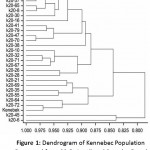 |
Figure 1: Dendrogram of Kennebec Population Generated from 20 Gy Irradiated Samples Based on all Assessed Traits. Horizontal axis shows percentage of similarity |
The grouping results of diversity levels for Kennebec population produced from 25 Gyirradiated sampleswere almost similar to that of Kennebec 20 so clones at 81% similarity were clssified into two groups (Figure 2). Theclone K25-47 lonely is placed in one group and others with primary parent are placed in another group.
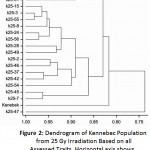 |
Figure 2: Dendrogram of Kennebec Population from 25 Gy Irradiation Based on all Assessed Traits. Horizontal axis shows percentage of similarity |
From grouping results for Banba population produced from 20 Gy irradiation it is known that similarity between clones is 83%, and all clones with the primary parent were placed into one group (Figure 3). At 85% similarity, the main parent placed into an independent group and other clones of this population were placed into another group. This means that the primary parent is different from other clones only about 15% of their genetic characteristics. The grouping results for Banba population from 25 Gy irradiation were slightly different from that of former 3 populations, and it is known that primary parent is similar to all produced populationfor about 68% of feature (Figure 4.With only about 20% of dissimilarity, the primary parent,the clones B25-1 and B25-10, and other clones were placed in three independent groups.According to results of cluster analysis we can say that irradiation at suitable gamma doses with environmental effects could induced maximum 20% variation in Kennebec and Banba varieties. Because environment affected many studied traits, and its effect can’t be separated from genotype effect, so we can’t clearly say that irradiation how much had influence on trait variation in potato.
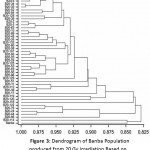 |
Figure 3: Dendrogram of Banba Population produced from 20 Gy Irradiation Based on all Assessed Traits. Horizontal axis shows percentage of similarity |
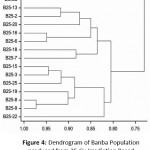 |
Figure 4: Dendrogramof Banba Population produced from 25 Gy Irradiation Based on all Assessed Traits. Horizontal axis shows percentage of similarity |
The Coefficient of Variation
The coefficient of variation was estimated in order to determine the irradiated-caused diversity for each trait (Figure 5), and these results showed that different gamma doseshavedifferent effects on various varieties of potato for any studied trait.Specific gravity, height, and tuber’s dry matter experienced the lowest variation. The highest variation belonged to yield and its components.Since yield and its components are quantitative traits, so it is a normal matter that higher degree of variations (diversity) belong to them. The observed diversity for Kennebec variety in the population produced from 20 Gy gamma dose was higher than that of 25Gy. Since the studied population was a selected population not a random one from primary population, the observed diversity can’t be directly attributed to radiation dose.About variation in flesh color of Kennebec variety which was the main goal of irradiation, 20 Gy dose was better than 25Gy. Irradiations at 20 and 25 Gy doses led to similar effect on Banba variety about the variation in flesh color. Since the effect of irradiation on the two varieties were different and the level of diversity was small (lower than 26%),we can’t onlyattribute the observed variation in the studied population to irradiation, and human errors (eye assessment of flesh color) and soil quality may play role in this variation.MousapourGorjiet al.[32] in this regard stated that potato’s flesh color is under influence of environmental conditions (weather and soil substrate) and this color for a specificvariety in favorable weather conditions is deeper than that of unfavorable weather conditions. Another main goal of irradiation in our project was to vary the dry matter of tuber in Banba variety. According to our findings 20Gy dose led to better outcomes than 25 Gy dose. The maximum estimated coefficient of variation for the percent of tuber’s dry matter was about 12% which isn’t reliable much. Regarding obtained results, we can conclude that the success degree of irradiation for improvement of various traits of potato is different and generally small.
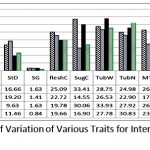 |
Figure 5: Coefficients of Variation of Various Traits for Interaction of Varieties and Doses. |
Dm = Dry matter, MTW = Mean of Tuber’s Weight, TubN = Tubers Number, TubW = Tuber Weight on Plant, SugC= Sugar Content, FleshC = Flesh Color, SG = Specific Gravity, StD = Stem Diameter, Nst = Number of Stems.
References
- Ahloowalia, B.S.,Maluszynski, M. Induced mutations – a new paradigm in plant breeding. Euphytica, 2001; 118(2): 167–173.
CrossRef - Singh, B. D. Plant breeding, Mutations in crop improvement. Kalayani pub.1990.
- Chen, Q.F., Wan, C.L., Lu, Y.M., Shen, M., Afza, R., Duren, M.V., and Brunner, H. Anther culture in connection with induced mutations for rice improvement. Euphytica , 2001;120:401– 408.
CrossRef - Saleem, M.Y., Mukhtar, Z., Cheema, A.A., Atta, B.M. Induced mutation and in vitro techniques as a method to induce salt tolerance in Basmati rice (Oryza sativa L.). International Journal of Environmental Science and Technology, 2005;2(4): 141– 145.
CrossRef - Predieri, S, Zimmerman, R.H. Pear mutagenesis: In vitro treatment with gamma-rays and field selection for productivity and fruit traits. Euphytica, 2001; 117(7):217–227.
CrossRef - Gulsen, O., Uzun, A., Pala, H., Canihos, E., and Kafa, G. Development of seedless and Mal Secco tolerant mutant lemons through budwood irradiation. Sciatica Horticulturae, 2007;112(4):184–190.
CrossRef - Ahloowalia, B.S. Plant Regeneration from Callus Culture in Potato. Euphytica, 1982;31(5):755-759.
CrossRef - International atomic energy agency (IAEA). In vitro techniques for selection of radiation induced mutations adapted to adverse environmental conditions. Plant breeding and genetics section joint FAO/IAEA division international atomic energy agency, Vienna, Austria, 2001;2(5): 95-96.
- Haghighi, R., Mar’ashi, S. H.,Nasiri, M. The Principles of Plant Breeding, Ferdowsi University of Mashhad. 1996
- Frazier, M.J., Kleinkopf, G.E., Brey, R.R., Olsen, N.L. Potato sprouts inhibition and tuber quality after treatment with high energy ionizing radiation. American Journal of Potato Research, 2006; 83(5):31–39.
CrossRef - Das, A., Gosal, S.S., Sidhu, J.S., and Dhaliwal, H.S. Induction of mutations for heat tolerance in potato by using in vitro culture and radiation. Euphytica, 2000; 114(2):205–209.
CrossRef - Gokmen, V., Akbudak, B., Serpen, A., Acar, J., Turan, Z.M., and Eris, A. Effects of controlled atmosphere storage and low-dose irradiation on potato tuber components affecting acrylamide and color formations upon frying. European Food Research and Technology, 2007;224(5):681–687.
CrossRef - Nayak, C.A., Suguna, K., Narasimhamurthy, K., and Rastogi, N.K. Effect of gamma irradiation on histological and textural properties of carrot, potato and beetroot. Journal of Food Engineering,2007; 79(2):765–770.
CrossRef - Al-Safadi, B., Ayyoubi, Z., and Jawdat, D. The effect of gamma irradiation on potato microtuber production in vitro. Plant Cell, Tissue and Organ Culture,2000; 61(6):183–187.
CrossRef - Shin, J.M., Kim, B.K., Seo, S.G., Jeon, S.B., Kim, J.S., Jun, B.k., Kang, S.Y., Lee, J.S., Chung, M.N., and Kim, S.H. Mutation breeding of sweet potato by gamma-ray radiation. African J. Agric. Res, 2011;6(6):1447-1454.
- Kukimura, H. Effects of gamma-rays on segregation ratios in potato families. Potato Research,1972;15:106–116.
CrossRef - Al-Safadi, B., and Arabi, M.I.E. In vitro induction, isolation and selection of potato mutants resistant to late blight. Journal of Genetics and Breeding, 2003;57:359–364.
- Al-Safadi, B., and Arabi, M.I.E. In vitro induction, isolation and selection of potato mutants tolerant to salinity. Advances in Horticultural Science,2007; 20(5):127–132.
- Cies´la, K., and Eliasson, A.C. Influence of gamma radiation on potato starch gelatinization studied by differential scanning calorimetry. Radiation Physics and Chemistry,2002; 64(3):137–148.
CrossRef - Baskaran, R., Usha Devi, A., Nayak, C.A., Kudachikar, V.B., KeshavaPrakash, M.N., Prakash, M., Ramana, K.V.R., and Rastogi, N.K. Effect of low-dose g-irradiation on the shelf life and quality characteristics of minimally processed potato cubes under modified atmosphere packaging. Radiation Physics and Chemistry,2007;76(2):1042–1049.
CrossRef - Wang, Y., Wang, F., Zhai, H., and Liu, Q. Production of a useful mutant by chronic irradiation in sweet potato. Sci. Horti, 2007;111(2):173-178.
CrossRef - Ahloowalia, B.S. Production of mini-tubers using a modular system of plant micropropagation. Potato Research,1999;42(5):569–575.
CrossRef - Gosal, S.S., Das, A., Gopal, J., Minocha, J.L., Chopra, H.R., Dhaliwal, H.S. In vitro induction of variability through radiation for late blight resistance and heat tolerance in potato. Biotechnology Centre, Punjab Agricultural University, Ludhiana, Punjab, India. 2001 Jun:7-13.
- Haverkort, A. J., Bicamumpaka, M. Correlation between intercepted radiation and yield of potato crops infested by Phytophthorainfestans in central Africa. Netherlands Journal of Plant Pathology. 1986 Sep 1;92(5):239-47.
CrossRef - Saif-Ur-Rasheed, M., Asad, S., Zafar, Y., Waheed, R.A. Use of radiation and in vitro techniques for development of salt tolerant mutants in sugarcane and potato. In vitro techniques for selection of radiation induced mutations adapted to adverse environmental conditions. 2001 Jun:61.
- Sharabash, MT. Radiation induced variation in potato for tolerance to salinity using tissue culture technique. In vitro techniques for selection of radiation induced mutations adapted to adverse environmental conditions. 2001 Jun:83.
- Ahloowalia, B.S. In vitro radiation mutagenesis in potato. Klawer Academic Publ, 1990.
- Sonnhno, A.G., Locardi, C.In vitro mutation breeding of potato.IAEA-SM.1985
- vanEnckevort, L.J., Hoogkamp, T.J., Bergervoet, J.E., Visser, R.G., Jacobsen E., Stiekema, W.J., Pereira ,A. Induction of recessive mutations in potato using tissue culture techniques. In vitro techniques for selection of radiation induced mutations adapted to adverse environmental conditions. 2001 Jun:15.
- Cheng, L., Yang, H., Lin, B., Wang, Y., Li, W., Wang, D., and Zhang, F., 2010. Effect of gamma-ray radiation on physiological, morphological characters and chromosome aberrations of minitubers in Solanumtuberosum L. Int. J. Radiat. 2010; 86(9):791–799.
CrossRef - Chetan, A.N., Suguna, K., Narasimhamurthy, K.,Rastogi, N.K. Effect of gamma irradiation on histological and textural properties of carrot, potato and beet root.J. Food Engineering, 2007;79(3):765-770.
CrossRef - MousapourGorji, A.,Mortazavibak, A., Hoseinzadeh, A.A., Mohamadi, A., Parvizi, K.,Shojaei, K. Investigation of Quantities and Qualitative Traits of New Potato Cultivars In Spring Culture, Karaj, Esfahan, Ardabil, Shahrood, Hamadan, Khorasan, Seed and Plant Improvement Institute,2009
- Hassanpanah, D., Rahimi, M.,Davoodi, S. Evaluation of Genetic Diversity of Qualitative Traits and Tuber’s Flesh Color in Potato Genotypes Generated from Gamma Irradiation in Caesar variety, Journal of Crop Ecophysiology,2015; 2(34): 215-230.
- MousapourGorji, A., Rahimi, M., Hajianfar, R.,Hassanpanah, D.The Creation of Genetic Diversity by Reciprocal Crossing and Mutation Methods and Selection of Single Superior Plant in Cultivars of Kennebec, Banba, Agria, Promising Clone of 397007 (Savalan), and Burren; Karaj, Ardebil, Seed and Plant Improvement Institute.2011

This work is licensed under a Creative Commons Attribution 4.0 International License.





